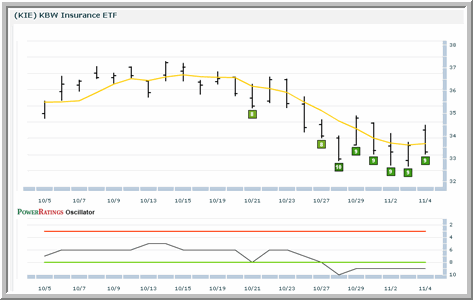ETF PowerRatings Strategies for Traders: Pullbacks in Financials
Among the top-rated exchange-traded funds (ETFs) in our database as of Thursday morning, a significant number of them are related to the financial industry. This includes not only ETFs representing banks, but also brokers and insurance based ETFs, as well.
When it comes to finding the best ETFs to trade for our ETF strategies — both PowerRatings strategies in specific as well as our high probability trading strategies in general — we know that country and equity index ETFs are at the top of the list. This is because our quantified testing has revealed that country and equity index ETFs do a superior job of moving back and forth between oversold and overbought conditions.

The KBW Bank ETF
(
KBE |
Quote |
Chart |
News |
PowerRating), which earned a top ETF PowerRating of 10, has been on our radar for the past several days as sellers have pushed the fund deeper into oversold territory above the 200-day moving average.
This tendency is a key aspect of our mean reversion strategy for trading exchange-traded funds in the short term. We buy oversold markets (“buying the selling”) and look to exit those oversold markets after they recover (“selling the buying”) and, in many cases, become overbought.
This is a professional approach to short term trading, and strategies based on this approach have served well professional traders and market makers for years if not decades. The unique opportunity for the average trader is that this professional trading strategy of buying weakness and selling strength has been quantified and fashioned into a variety of high probability ETF trading strategies, including ETF PowerRatings.

Also with an ETF PowerRating of 10, the iShares Dow Jones U.S. Broker-Dealers Index Fund ETF
(
IAI |
Quote |
Chart |
News |
PowerRating) has closed lower for three out of the past four trading days.
While country and equity index ETFs are our top choices, sector ETFs — such as those listed here representing financials — are right in line behind them when it comes to our high probability trading strategies for ETFs. One issue with sector ETFs is that their lack of diversification — including all bank stocks or all REITs or all insurance companies — means that sector ETFs will tend to have much greater sector risk compared to more broad based ETFs representing whole countries or whole stock markets.
In practice, this means that if a particular sector falls out of favor, the ETFs representing that sector could find itself becoming even more extremely oversold than usual and struggle to revert back to its mean compared to other ETFs we use in our trading strategies such as country and index ETFs.

The one 9-rated ETF in today’s report, the KBW Insurance ETF
(
KIE |
Quote |
Chart |
News |
PowerRating) remains a potentially attractive trading candidate even after its ETF PowerRating slipped from 10 to 9 several days ago.
That said, sector ETFs have performed well in our testing of a variety of high probability ETF trading strategies. The Financial Select Sector SPDRS ETF
(
XLF |
Quote |
Chart |
News |
PowerRating), for example, produced accuracy rates of more than 91% in 59 trades since inception in one high probability ETF trading strategy called TPS. In this, the XLF actually outperformed a number of country ETFs from places like Asia and Latin America.
So while country and equity index ETFs are our top choices when it comes to ETF trading strategies, sector ETFs like those noted in this report can be excellent alternatives – especially when their ETF PowerRatings are in the “consider buying” range of 8, 9 or 10.
Did you know that our PowerRatings work for exchange-traded funds too? If you’ve been looking for help in trading ETFs in both bull and bear markets, then our ETF PowerRatings may provide the solution you are looking for. Click here to start your free, 7-day trial today!
David Penn is Editor in Chief at TradingMarkets.com.
